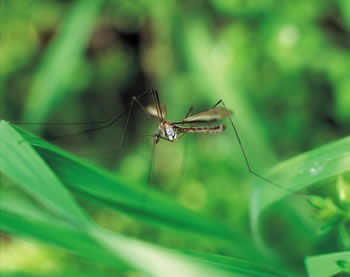
There are over 2,500 types of mosquitoes throughout the world. North America is home to over 200 species of mosquitoes. Mosquitoes come in many different sizes. Adult mosquitoes have long, delicate legs, a long proboscis, and a pair of transparent wings. Most are less than 1 centimeter in length. Under a microscope, the mosquito body looks covered in scales. HABITAT
Mosquitoes are found in many different habitats throughout the world. Mosquitoes, however, need to be near fresh water, or slightly salty water for their larva to grow. Any source of water can sustain mosquito populations including marshes, swamps, lakes, ponds, puddles, or even the smallest accumulation of water in a gutter, bucket, or dish. Mosquitoes are most common and diverse in humid habitats, but are also common near the ocean and even in the arctic tundra.
FOOD
Female mosquitoes survive by sucking the blood of animals and humans. Mosquitoes also suck nectar from flowers. Interestingly enough, mosquitoes are attracted to humans by the carbon dioxide we exhale, from body heat, and from bacteria that live on our skin. Mosquitoes can detect exhaled carbon dioxide from as far away as 75 feet. Personal body chemistry may determine why some people seem to get bitten by mosquitoes more than others. Different mosquitoes target different parts of the body. Some may buzz around your eyes and ears, while others target areas behind your elbows or knees.
MOSQUITO BITES
Mosquito bites itch because of the chemicals and proteins injected into your body during a bite. The chemicals help to enlarge blood vessels and to prevent the blood from clotting. This helps the mosquito to extract blood from its victim. The chemicals cause irritation which causes the immune system to create a bump. Different species of mosquitoes cause different sized and shaped bites.
DISEASE
Throughout history, mosquitoes have been one of the most prolific carriers of deadly diseases on the planet. Malaria, Yellow Fever, Encephalitis, and Dengue are among the deadly diseases transmitted from mosquitoes to human beings. Diseases from mosquitoes have been responsible for the deaths of millions of people in last two or three hundred years. Most recently, mosquitoes have been identified as the carrier of the West Nile Virus. Many mosquito-borne diseases such as Malaria have been eradicated in developed countries such as the United States. Eradicated means people can no longer get the disease. However, over one million people die from Malaria every year in tropical, undeveloped countries where Malaria has not been eradicated.
|